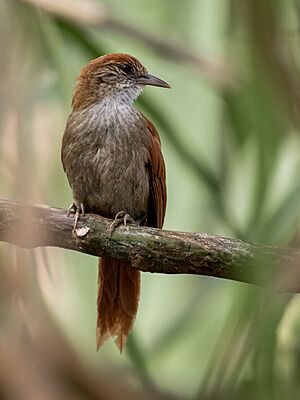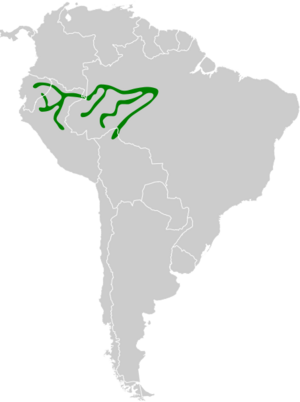Parker's spinetail facts for kids
Quick facts for kids Parker's spinetail |
|
|---|---|
 |
|
| At Marchantaria island, Iranduba, Amazonas state, Brazil | |
| Conservation status | |
| Scientific classification | |
| Genus: |
Cranioleuca
|
| Species: |
vulpecula
|
 |
|
| Synonyms | |
|
Cranioleuca vulpina vulpecula |
|
The Parker's spinetail (Cranioleuca vulpecula) is a small bird that belongs to the ovenbird family called Furnariidae. You can find this bird in parts of Bolivia, Brazil, Ecuador, and Peru.
Contents
About the Parker's Spinetail
This bird was first named Synallaxis vulpecula. For a while, people thought it was just a type of rusty-backed spinetail. But later, scientists realized it was its own special species. They also found out it's actually more closely related to the russet-mantled softtail. The Parker's spinetail is a unique species, meaning it doesn't have any different subspecies.
What Does Parker's Spinetail Look Like?
Parker's spinetail is about 13 to 16 cm (5.1 to 6.3 in) long. That's roughly the size of a small sparrow. It weighs around 16 to 20 g (0.56 to 0.71 oz), which is very light! Both male and female birds look the same.
They have a light, faint buff stripe above their eyes. Their face is mostly dusky gray. The top of their head, back, and tail feathers are a reddish-brown color, called rufous. Their tail and wings are also rufous.
Their throat is white, and the rest of their belly is light brown or grayish-brown. Their eyes are brown, and their beak is black on top and pale grayish-pink on the bottom. Their legs and feet are olive or grayish-olive. Young birds have a duller color on their heads than adult birds.
Where Parker's Spinetail Lives
This bird lives along the upper Amazon River and its big branches. You can find it in eastern Ecuador, northeastern Peru, northern Bolivia, and western Brazil. It mostly lives on new river islands that have just started to form. These islands have young plants growing on them. It usually lives below 300 m (1,000 ft) in height, but sometimes it can be found up to 400 m (1,300 ft) in Ecuador.
Parker's Spinetail Behavior
How Parker's Spinetail Moves Around
Parker's spinetail does not migrate long distances. However, we don't know how much it moves locally. It might move around when river islands flood during the rainy season.
What Parker's Spinetail Eats
Parker's spinetail eats small bugs and other arthropods. It usually hunts for food in the lower and middle parts of trees and bushes. These birds often search for food in pairs. They pick their prey off tree bark, dead leaves, and trapped plant bits. They look along tree trunks and branches for their meals.
Vocalization of Parker's Spinetail
The song of the Parker's spinetail sounds like a series of fast, nasal notes that go down in pitch. It ends with a gurgling sound, like "tew-tew-tew-tew-trrrrrr". Another way to describe its song is an accelerating, rising and falling chatter of nasal notes: "teer teew-tew'tu'tutrrr". Its calls include a sharp, quick "chut-chut" sound. This call can be given once or three times. It also makes a longer, descending chatter, like "tchew-tew'tu'tu".
Status and Conservation
The IUCN (International Union for Conservation of Nature) has listed Parker's spinetail as a species of "Least Concern." This means it is not currently in danger of disappearing. It lives across a large area, and its population size is thought to be stable.
Scientists haven't found any immediate big threats to this bird. It is considered uncommon to fairly common in Peru. It is fairly common in Ecuador and other parts of its range. Human activities usually don't harm Parker's spinetail much in the short term. In fact, it might even benefit from some human activities, like small amounts of land clearing for farming. This is because it lives in areas that have been disturbed. However, big changes to the Amazon River's water flow could be a problem. Things like cutting down too many trees, building dams, or climate change could affect its habitat in the long run.


